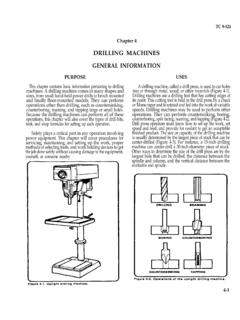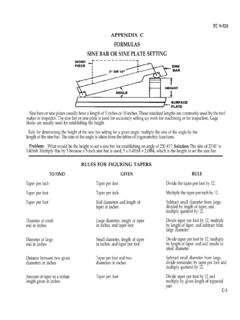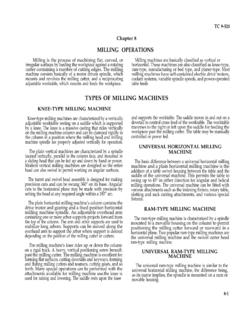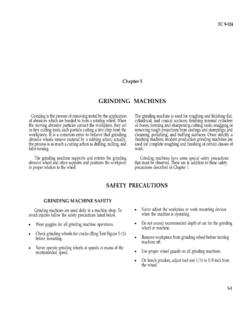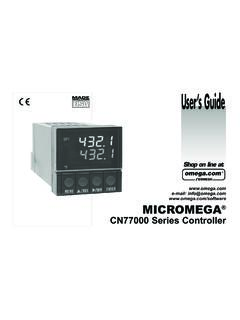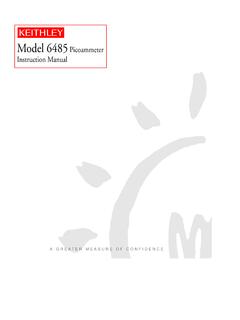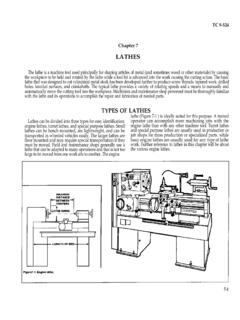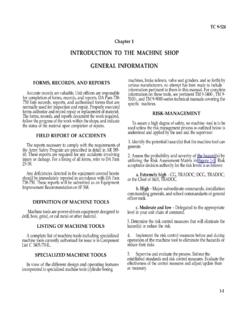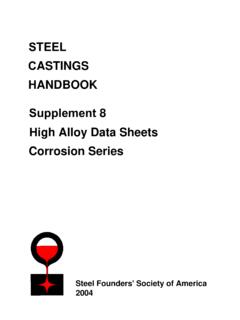Transcription of PROPERTIES, IDENTIFICATION, AND HEAT TREATMENT OF …
1 TC 9-524 Chapter 2 PROPERTIES, IDENTIFICATION, ANDHEAT TREATMENT OF METALSGENERALPURPOSEThis chapter contains basic information pertaining toproperties and identification of metal and heat -treatingprocedures used for metals. For more specific information onmetal and heat -treating techniques, refer to TM CLASSIFICATIONAll metals may be classified as ferrous or nonferrous. Aferrous metal has iron as its main element. A metal is stillconsidered ferrous even if it contains less than 50 percent iron,as long as it contains more iron than any other one metal. Ametal is nonferrous if it contains less iron than any metals include cast iron, steel, and the various steelalloys, The only difference between iron and steel is the carboncontent. Cast iron contains more than 2-percent carbon, whilesteel contains less than 2 percent. An alloy is a substancecomposed of two or more elements. Therefore, all steels arean alloy of iron and carbon, but the term alloy steel normally refers to a steel that also contains one or more otherelements.
2 For example, if the main alloying element istungsten, the steel is a tungsten steel or tungsten alloy. Ifthere is no alloying material, it is a carbon steel. NonferrousNonferrous metals include a great many metals that are usedmainly for metal plating or as alloying elements, such as tin,zinc, silver, and gold. However, this chapter will focus onlyon the metals used in the manufacture of parts, such asaluminum, magnesium, titanium, nickel, copper, and 9-524 GENERALPROPERTIES OF METALSThe internal reactions of a metalknown as mechanical properties. Theto external forces aremechanical propertiesare directly related to each other. A change in one propertyusually causes a change in one or more additional example, if the hardness of a metal is increased, thebrittleness usually increases and the toughness usuallydecreases. Following is a brief explanation of the mechanicalproperties and how they relate to each STRENGTHT ensile strength is the ability of a metal to resist being pulledapart by opposing forces acting in a straight line (Figure 2-1).
3 It is expressed as the number of pounds of force required topull apart a bar of the material 1 inch wide and 1 inch STRENGTHS hear strength is the ability of a metalfractured by opposing forces not acting into resist beinga straight line(Figure 2-2). Shear strength can be controlled by varying thehardness of the 9-524 COMPRESSIVE STRENGTHC ompressive strength is the ability of a metal to withstandpressures acting on a given plane (Figure 2-3).ELASTICITYE lasticity is the ability of metal to return to its original sizeand shape after being stretched or pulled out of shape (Figure2-4).DUCTILITYD uctility is the ability of a metal to be drawn or stretchedpermanently without rupture or fracture (Figure 2-5). Metalsthat lack ductility will crack or break before is the ability of a metal to be hammered,rolled, or pressed into various shapes without rupture orfracture (Figure 2-6).
4 2-3TC 9-524 TOUGHNESST oughness is the ability of a metal to resist fracture plusthe ability to resist failure after the damage has begun. Atough metal can withstand considerable stress, slowly orsuddenly applied, and will deform before is the ability of a metal to resist penetration andwear by another metal or material. It takes a combination ofhardness and toughness to withstand heavy pounding. Thehardness of a metal limits the ease with which it can bemachined, since toughness decreases as hardness hardness of a metal can usually be controlled by AND WELDABILITYM achinability and weldability are the ease or difficultywith which a material can be machined or RESISTANCEC orrosion resistance is the resistance to eating or wearingaway by air, moisture, or other AND ELECTRICAL CONDUCTIVITYHeat and electrical conductivity is the ease with which ametal conducts or transfers heat or is the tendency of a material to fracture orbreak with little or no deformation, bending, or is usually not a desirable mechanical , the harder the metal, the more brittle it OF METALSGENERALPart of the metalworker s skill lies in the ability to identifyvarious metal products brought to the shop.
5 The metalworkermust be able to identify the metal so the proper work methodscan be applied. For Army equipment , drawings should beavailable. They must be examined in order to determine themetal to be used and its heat TREATMENT (if required). If nodrawing is available, knowledge of what the parts are going todo will serve as a guide to the type of metal to OF METALSS imple tests can be made in the shop to identify the ability to judge metals can be developed onlythrough personal experience, practice these tests with knownmetals until familiar with the reactions of each metal to eachtype of TestThis test includes such things as the color and appearanceof machined as well as unmachined TestSome metals can be quickly identified by looking at thesurface of the broken part or by studying the chips producedwith a hammer and TestThis is a simple identification test used to observe thecolor, spacing, and quantity of sparks produced by grinding.
6 Itis a fast and convenient method of sorting mixed steels withknown spark characteristics. This test is best conducted byholding the steel stationary and touching a high-speed portablegrinder to the steel with sufficient pressure to throw a sparkstream about 12 inches long. The characteristics of sparksgenerated by a spark grinding test are shown in Figure spark patterns provide general information about thetype of steel, cast iron, or alloy steel. In all cases, it is best touse standard samples of metal when comparing their sparkswith that of the test 9-5242-5TC 9-524 THE ROCKWELL HARDNESS NUMBER ISDETERMINED BY THE DEPTH OF THEIMPRESSION WHILE THE BRINELL HARDNESSNUMBER IS DETERMINED BY THE AREA OF THEIMPRESSIONFile TestOne simple way to check for hardness in a piece of metal isto file a small portion of it. If it is soft enough to be machinedwith regular tooling, the file will cut it.
7 If it is too hard tomachine, the file will not cut it. This method will indicatewhether the material being tested is softer or harder than thefile, but it will not tell exactly how soft or hard it is. The filecan also be used to determine the harder of two pieces ofmetal; the file will cut the softer metal faster and easier. Thefile method should only be used in situations when the exacthardness is not required. This test has the added advantage ofneeding very little in the way of time, equipment , Hardness TestThis test determines the hardness of metals by measuring thedepth of impression which can be made by a hard test pointunder a known load. The softer the metal, the deeper theimpression. Soft metals will be indicated by low hardnessnumbers. Harder metals permit less of an impression to bemade, resulting in higher hardness numbers. Rockwellhardness testing is accomplished by using the Rockwellhardness testing machine (Figure 2-8).
8 Brinell Hardness FestBrinell hardness testing operates on almost the sameprinciple as the Rockwell test. The difference between the twois that the Rockwell hardness number is determined by thedepth of the impression while the Brinell hardness number isdetermined by the area of the impression. This test forces ahardened ball, 10 mm ( in) in diameter, into the surfaceof the metal being tested, under a load of 3,000 kilograms(approximately 6,600 lb). The area of this impressiondetermines the Brinell hardness number of the metal beingtested. Softer metals result in larger impressions but havelower hardness CODESP erhaps the best known numerical code is the Society ofAutomotive Engineers (SAE) code. For the metals industry,this organization pioneered in developing a uniform codebased on chemical analysis. SAE specification numbers arenow used less widely than in the past; however, the SAEnumerical code is the basic code for ferrous metals Figure 2-9).
9 The SAE system is based on the use of four-or five first number indicates the type of alloy used; forexample, 1 indicates a carbon indicates nickel second, and sometimes the third, number gives theamount of the main alloy in whole percentage last two, and sometimes three, numbers give thecarbon content in hundredths of 1 percent ( percent).2-6TC 9-524 The following examples will help you understand thisSAE 1045system:1- Type of steel (carbon).0- Percent of alloy (none).45- Carbon content ( carbon).2-7TC 9-524 SAE 23302- Type of steel (nickel).3- Percent of alloy (3-percent nickel).30- Carbon content ( carbon).SAE 716507- Type of steel (tungsten).16- Percent of alloy (16-percent tungsten).50- Carbon content (0,50-percent carbon).SAE 501005- Type of steel (chromium).0- Percent of alloy (less than l-percent chromium).100- Carbon content (1-percent carbon).AA CodeA system similar to the SAE classifications for steel andalloys has been developed by the Aluminum Association (AA)for wrought aluminum and aluminum identification system of aluminum, as shown in Figure2-10, consists of a four-digit number which indicates the typeof alloy.
10 Control over impurities, and the specific alloy. Thefirst number indicates the type of alloy. For example, 2 iscopper, 3 is manganese, 4 is silicone, and so forth. The secondnumber indicates the control that has been used. The last twonumbers usually indicate an assigned composition. Thus, AA-2024 means:2 - Type of alloy (copper).O - Control of - Exact composition (AA number 24).Aluminum alloys vary greatly in their hardness andphysical condition. These differences are called temper, Letter symbols represent the different tempers, In addition to aletter, one or more numbers are sometimes used to indicatefurther differences. The temper designation is separated fromthe basic four-digit identification number by a dash; for ex-ample, 2024-T6. In this case there is an aluminum alloy, 2024,with a T6 temper (solution heat treated and then artificiallyaged). Figure 2-11 shows the numerals 2 through 10 that havebeen assigned in the AA system to indicate specific sequencesof annealing, heat treating, cold working, or 9-524A stencilMETHODS OF MARKINGS tencilingand white or black paint, whichever shows upStampingStamping the specification number into the metal should bebetter on the metal being marked, should be used when theused when it is impossible to use the stencil method.
